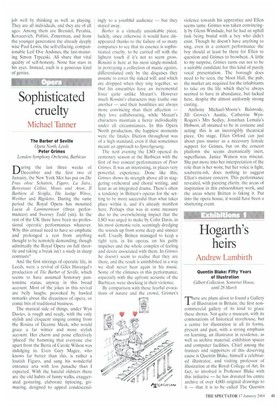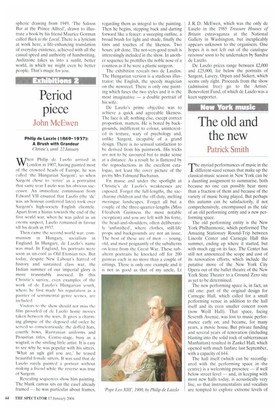Hogarth's heirs
Andrew Lambirth
Quentin Blake: Fifty Years of illustration Gilbert Collection, Somerset House, until 28 March
There are plans afoot to found a Gallery of Illustration in Britain, the first noncommercial gallery of its kind to grace these shores. Not quite a museum, with its connotations of historical storehouse, but a centre for illustration in all its forms, present and past, with a strong emphasis on learning, an illustrator in residence, as well as archive material, exhibition spaces and computer facilities. Chief among the trustees and supporters of this deserving cause is Quentin Blake, himself a celebrated illustrator, and visiting professor of illustration at the Royal College of Art. In fact, so involved is Professor Blake with this initiative — he has donated his entire archive of over 4,000 original drawings to it — that it is to be called The Quentin
Blake Gallery of Illustration. As yet no permanent home has been found for it, but a choice selection of Blake's gift is temporarily on show in the Gilbert Collection. Will the Gallery manage to put down roots in the redeveloped riverside wing of Somerset House? It might turn out to be the perfect setting for it.
Undoubtedly there is a pressing need for a Gallery of Illustration. As an art form, it is all too evident that illustration has for too long been disparaged, while in comparison 'fine art' has been unfairly promoted. Very few painters manage to operate successfully as both illustrators and artists (Peter Blake is an honourable exception), despite the glorious tradition of illustration this country possesses. Just think, for a moment, of Hogarth, Cruikshank and Tenniel. Today we have Ralph Steadman, Glen Baxter and Quentin Blake — none of them recognised as artists, but rather snootily categorised as cartoonists or illustrators.
The handsomely designed and illustrated prospectus informs us that 'the fundamental premise of the Gallery will be that illustration is not only an art and craft in its own right, but provides an unthreatening access to the visual arts and a powerful motivation to literacy'. I don't know about 'unthreatening' when you contemplate the deadpan horrors of Maurice Sendak or Raymond Briggs, but anything that promotes literacy and the accessibili
ty of the visual arts must be encouraged. Certainly the 'craft' element of illustration fits neatly with the Gilbert Collection's extraordinary array of excellence in applied-art craftsmanship. And the power of illustration to communicate on a very direct level, while it must never be underestimated, should also be harnessed if at all possible to a greater appreciation of the arts in general.
Quentin Blake (born 1932) is just the right sort of artist to be spearheading this campaign. For many years a teacher — he started at the Royal College in 1965 and stayed for more than two decades, ending up as head of the department of illustration (1978-86) — he is also an immensely distinguished writer and illustrator of international standing. His inspired collaborations with Roald Dahl brought him instant acclaim, and he went on to capitalise on this success by extending his activities in all directions. The current selection of his work at the Gilbert Collection ranges from his first published drawing, done for Punch in 1949 while still a schoolboy, to his most recent projects, such as the delightful Mrs Armitage, Queen of the Road. I only wish there was a bit more on show. Admission is .E5, and although this also gets you into the Gilbert Collection's gold and silver displays not everyone will want to relish them.
However, the samples of Blake's work which are on show are laid out with a pleasing informality, with Blake himself writing pencil annotations on the wooden floors of the flat display cases. From the beginning, in a couple of pen-and-wash studies of the railway line seen from his Sidcup bedroom, an impressive graphic assurance is revealed. Working through an apprenticeship to Punch, and to this magazine (the covers of which Blake regularly designed), he quickly developed an immediately recognisable style — slightly spiky and wayward, fantastical even, but sharply observant, instinctively simplifying, and gin-clear. An acuity of wit gentled with humour, a lucid linear shorthand deftly embellished with exact quantities of colour, tonal control — Blake has all these, and also the necessary edge of anarchy and subversion, which lifts his work above most of his contemporaries. The exhibition is charming and friendly, with just that hint of danger lurking in the background to make it memorable.
The much-loved work of Edward Ardizzone (1900-79) would be a perfect subject for detailed examination at the Gallery of Illustration. Certainly Quentin Blake himself admires it, for in his selection of 50 favourite children's books, The Laureate's Party, he pays tribute to the 'simple but magical' quality of Ardizzone's art But, in the meantime, Wolseley Fine Arts is mounting a select selling exhibition of Ardizzone's original book illustrations, together with a few lithographs and oil paintings, at Gallery 27 in Cork Street, London Wl, from 20 to 31 January. (The show will later tour to Hay School in Hayon-Wye. 28 May to 6 June.) Ardizzone, born of an Italian father brought up in France, and a half-Scots half-English mother, learnt to love literature at his mother's knee when she read Dickens to him. This seems to be a pre-requisite of all great illustrators — that they love the words they illumine — but it was some years before the young man had the courage to give up his job as a ledger clerk in the City and launch himself as a freelance artist/illustrator.
This exhibition presents work from 1930 on, dealing with the early period when Ardizzone worked regularly for the Radio Times (1932-56), embarked upon the famous Little Tim books and designed adverts for Guinness, culminating in his work as a War Artist. His postwar style is ever more rounded and assured, gentle and joyful. Whatever his subject, Ardizzone maintained it was as important to invent as to observe, and to keep a wellstocked visual memory together with a varied knowledge of how people behave in different circumstances. He combined this approach with a distinctively trenchant linear style, softened with cross-hatching. He always maintained that he pictured a scene as taking place on stage before he drew it, viewed from a 'good seat' in the stalls. Look, for instance, at the intensely atmo spheric drawing from 1949, 'The Saloon Bar at the Prince Alfred', drawn to illustrate a book by his friend Maurice Gorman called Back to the Local. There is a lyricism at work here, a life-enhancing translation of everyday existence, achieved with all the casual speed and authority of handwriting. Ardizzone takes us into a sunlit, better world, in which we might even he better people. That's magic for you.




































































 Previous page
Previous page